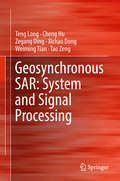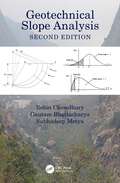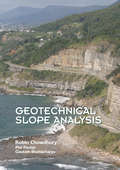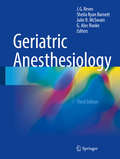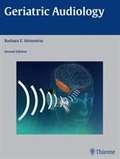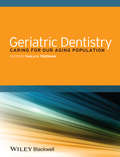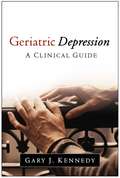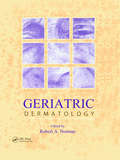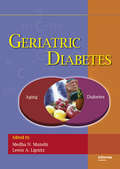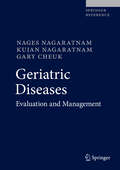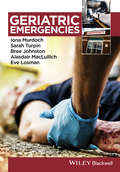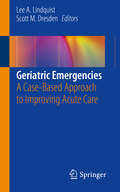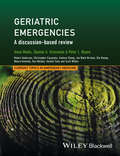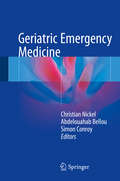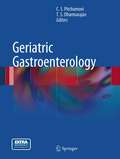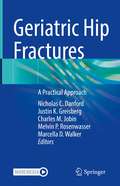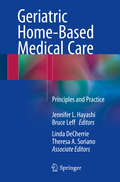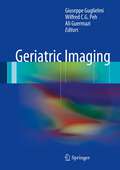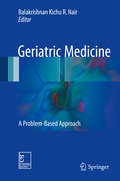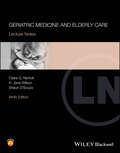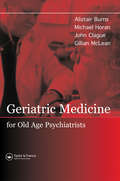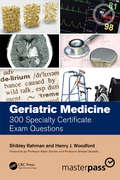- Table View
- List View
Geosynchronous SAR: System and Signal Processing
by Teng Long Cheng Hu Zegang Ding Xichao Dong Weiming Tian Tao ZengThis book chiefly addresses the analysis and design of geosynchronous synthetic aperture radar (GEO SAR) systems, focusing on the algorithms, analysis, methods used to compensate for ionospheric influences, and validation experiments for Global Navigation Satellite Systems (GNSS). Further, it investigates special problems in the GEO SAR context, such as curved trajectories, the Earth’s rotation, the ‘non-stop-and-go’ model, high-order Doppler parameters, temporal-variant ionospheric errors etc. These studies can also be extended to SAR with very high resolution and long integration time. Given the breadth and depth of its coverage, scientists and engineers in SAR and advanced graduate students in related areas will greatly benefit from this book.
Geotechnical Slope Analysis
by Gautam Bhattacharya Robin Chowdhury Subhadeep MetyaThis second edition of Geotechnical Slope Analysis is an updated version of the original scholarly book. In this edition, concepts and applications have been thoroughly revised. In particular, the ‘Initial Stress Approach’ has been extended to 2D problems in a more rigorous manner. Additional solved numerical examples have been added in several chapters. More importantly, the meaning of the results is explored through interpretation. The influence of initial stresses, pore water pressures and seismic forces has been explored not only on performance indicators such as the ‘Factor of Safety’ but also on the location of critical slip surfaces. In addition to these factors, it is shown that the chosen method of analysis may also have a significant influence on the location of the critical slip surface. Student exercises have been included in some chapters with a view to encouraging further study and research, and reference is often made to case studies of particular importance. The best features of the book have been retained with continued emphasis on both deterministic and probabilistic approaches for quantifying slope performance. The traditional performance indicator such as ‘Factor of Safety’ can be complemented by the calculation of the ‘Reliability Index’ and the ‘Probability of Failure’. This book focuses on research studies concerning slope behaviour, the occurrence of landslides and the use of alternative methods of analysis and interpretation. The importance of uncertainties in slope performance and, more broadly, in geotechnical engineering is emphasised. This book will be valuable to undergraduate and senior students of civil, mining and geological engineering as well as to academic teachers and instructors and also to researchers, practising geotechnical engineers and consultants.
Geotechnical Slope Analysis
by Gautam Bhattacharya Robin Chowdhury Phil FlentjeFreshly updated and extended version of Slope Analysis (Chowdhury, Elsevier, 1978). This reference book gives a complete overview of the developments in slope engineering in the last 30 years. Its multi-disciplinary, critical approach and the chapters devoted to seismic effects and probabilistic approaches and reliability analyses, reflect the distinctive style of the original. Subjects discussed are: the understanding of slope performance, mechanisms of instability, requirements for modeling and analysis, and new techniques for observation and modeling. Special attention is paid to the relation with the increasing frequency and consequences of natural and man-made hazards. Strategies and methods for assessing landslide susceptibility, hazard and risk are also explored. Moreover, the relevance of geotechnical analysis of slopes in the context of climate change scenarios is discussed. All theory is supported by numerous examples.''...A wonderful book on Slope Stability....recommended as a refernence book to those who are associated with the geotechnical engineering profession (undergraduates, post graduates and consulting engineers)...'' Prof. Devendra Narain Singh, Indian Inst. of Technology, Mumbai, India''I have yet to see a book that excels the range and depth of Geotechnical Slope Analysis... I have failed to find a topic which is not covered and that makes the book almost a single window outlet for the whole range of readership from students to experts and from theoreticians to practicing engineers...'' Prof. R.K. Bhandari, New Delhi, India
Geriatric Anesthesiology
by Sheila Ryan Barnett J. G. Reves Julie R. Mcswain G. Alec RookeSurgical and anesthetic techniques have evolved to allow a growing number of older adults to undergo surgery, and current estimates are that 50% of Americans over the age of 65 years old will have an operation. However, as the knowledge regarding perioperative care of the elderly surgical patient grows, so do the questions. In this edition, each chapter includes a section entitled "Gaps in Our Knowledge," meant to highlight areas in which research is needed, as well as hopefully inspire readers to begin solving some of these questions themselves. Building upon the strong foundation of the first two editions, Geriatric Anesthesiology, 3rd edition also assembles the most up-to-date information in geriatric anesthesia and provides anesthesiologists with important new developments. Topics covered include several new chapters that reflect the evolution of multidisciplinary geriatric care throughout the perioperative continuum, as well as the growing body of literature related to prehabilitation. In addition, discussion of the surgeon's perspective and geriatrician's perspective on surgery in the geriatric population is covered, as well as the systematic physiologic changes associated with aging and the pharmacologic considerations for the geriatric patient undergoing procedures. Finally, the last section discusses postoperative care specific to the geriatric population, including acute pain management, ICU management, recent evidence and up-to-date practice regarding delirium and postoperative cognitive dysfunction, and palliative care.
Geriatric Audiology
by Barbara WeinsteinCompletely revised and updated, Geriatric Audiology, Second Edition is a unique handbook that provides audiologists, speech language pathologists, and doctoral students in audiology with evidence-based, clinical guidance on evaluating and treating hearing loss in older adults. Focusing solely on geriatric audiology, this new edition contains the latest information on the demographics of aging as well as the biological, sociological, and psychological factors that affect geriatric hearing loss and its ramifications.
Geriatric Dentistry
by Paula K. FriedmanGeriatric Dentistry: Caring for Our Aging Population provides general practitioners, dental students, and auxiliary members of the dental team with a comprehensive, practical guide to oral healthcare for the aging population. Beginning with fundamental chapters on the psychological, environmental, and social aspects of aging, the book approaches patient care from a holistic point of view. Subsequent chapters show the importance of this information in a practical context by discussing how it affects office environment, decision?-making and treatment planning, and the management and treatment of common geriatric oral conditions. Case studies and study questions are used to illustrate application of educational presentations to practice settings. Contributed by leaders in the field, Geriatric Dentistry will strengthen readers' understanding and clinical acumen in addressing this special population.
Geriatric Depression
by Gary J. KennedyWritten for a broad range of mental health professionals, this book explains why depression can be challenging to treat in older adults and describes the most effective interventions. Noted geriatric psychiatrist Gary J. Kennedy draws on extensive clinical experience and research to present current best practices in pharmacotherapy, psychotherapy, other psychosocial and lifestyle interventions, and electroconvulsive therapy. Depressive disorders complicated by psychosis, mania, dementia, and bereavement are addressed in detail, as is suicide prevention. Kennedy emphasizes the importance of integrating care across service settings and building strong partnerships with patients and their families. Quick-reference tables throughout the book distill critical elements of intervention. See also the author's award-winning Geriatric Mental Health Care: A Treatment Guide for Health Professionals, which provides a framework for treating the most frequently encountered psychiatric problems in this population.
Geriatric Dermatology (Clinical Cases In Dermatology Ser. #0)
by Robert A. NormanOver the past few years the world's population has continued on its remarkable transition from a state of high birth and death rates to one characterized by low birth and death rates. Consequently, primary care physicians and dermatologists will see more elderly patients presenting age-related dermatological conditions. There has never been a better time for a book devoted entirely to skin care in the elderly.Geriatric Dermatology draws together a panel of experts who provide an overview of the diagnosis and treatment of geriatric skin diseases. It begins with a general review of the aging of the world's population and the major dermatological problems that often arise in elderly patients. An added benefit is the book's coverage of geriatric skin care in nursing homes, adult congregate living, and subacute and home health settings, a subject not always found in conventional dermatology texts.The book includes:A summary of the dermatological disorders frequently encountered in the elderly, including eczematous dermatitis, skin infections, and neoplasiasA description of the most common geriatric hair and scalp disorders, including graying, alopecia, and scalp psoriasisComprehensive coverage of the diagnosis and treatment of leg, foot, and nail diseasesDetailed discussion of the treatment of superficial mycoses, scabies, and pediculosisLess common geriatric conditions such as blistering diseases Major adverse drug reactions on the skinLeg ulcers due to venous insufficiency, arterial diseases, and diabetic nephropathyDiagnosis and treatment of diabetic complications of dermatology, such scleroderma and dermopathyThe study of diseases that impact the elderly population is a crucial and growing area of interest in medicine. Geriatricians, primary care physicians, dermatologists, and others involved in the care of the elderly will inevitably see an increase in skin diseases specific to aging. The comprehensive coverage provided by Geriatric Dermatology facilitates the diagnosis and management of these geriatric skin diseases from the common to the rare and unusual.
Geriatric Diabetes
by Medha N. Munshi Lewis A. LipsitzThe number of elderly patients with diabetes is increasing at a significant rate. Responding to this growth, this source serves as a solid arsenal of information on the varying presentations and challenges associated with diabetes in the geriatric patient, and supplies clearly written sections on the screening, diagnosis, and treatment of diabetes
Geriatric Diseases: Evaluation And Management
by Nages Nagaratnam Kujan Nagaratnam Gary CheukThis volume provides a comprehensive overview of the unique clinical entities of diseases in older patients. The book arranges the organ systems in 21 sections, which include over 100 collective chapters on various age-related diseases in these organ systems. The text is specifically designed for ease-of-use and include learning tools that include multiple choice, short answer, and extended matching questions, case vignettes, self-assessments, and rich tables and illustrations. Each section includes a review of the anatomy, physiology and pathology that are specific to aging patients. The text covers the complex factors that present diagnosis challenges, including the interaction of the disease process with co-existing morbidities, aged- related physiological changes and pre-existing functional challenges and psychosocial circumstances. The text also works with the previously published text Diseases in the Elderly: Age-Related Changes and Pathophysiology, which is tailored to complement this resource.Written by experts in the field, Geriatric Diseases: Clinical Expression, Management and Impact is the ultimate guide on clinical expression and management of diseases in the elderly for medical students, residents, fellows, geriatricians, gerontologists, primary care physicians, internal medicine specialists, emergency room physicians, specialist nurses, and all other physicians and medical professionals treating older patients.
Geriatric Drug Therapy Interventions
by James W CooperMedication costs and common drug-related problems, such as misapplication of therapy, medication misuse, and adverse effects, can often be avoided or reduced. Geriatric Drug Therapy Interventions will help you get better outcomes with your patients as it points out pitfalls to avoid and provides you with logical principles for administering drug therapy. Offering guidelines, advice, and gentle reminders, this book shows you the importance of properly documenting patient problems and of considering the entire medical history of your patients. It also helps you perform fall and psychoactive drug risk assessments and address under-recognized and undertreated problems such as malnutrition, depression, sensory deficits, anemia, osteoporosis, and pressure ulcers.As Geriatric Drug Therapy Interventions clarifies, increased consultant pharmacist involvement in comprehensive pharmaceutical services results in the reduction of drug-related problems and medication-associated costs with long-term care patients. Using this book's helpful and substantive interventions, you can improve clinical, economic, and humanistic outcomes in your practice. For this purpose, Geriatric Drug Therapy Interventions discusses: a study designed to teach pharmacy students to identify, document, solve, and prevent medication-related problems providing patient-focused care and assuming responsibility for patient outcomes reimbursing pharmacists for performing cognitive service and cost-savings activities how the prevalence of drug-related problems that influence the need for hospital and nursing home admissions increases with age reasons for patient noncompliance NSAID-associated gastritis, gastrointestinal bleeding, drug-induced delirium, incontinence, and constipation why the advent of managed care does not bode well for the overall health outcomes of the elderlyPharmacists, physicians, and other health care providers can't control all aspects of drug use, but there are many practical steps you can take to help your patients use their prescriptions appropriately. Geriatric Drug Therapy Interventions will help you monitor the efficacy of drug therapy, guide patients who are exasperated with being poked, prodded, and barraged with medications, and work together to develop therapy patterns and schedules that are effective and comfortable.
Geriatric Emergencies
by Sarah Turpin Iona Murdoch Bree Johnston Alasdair Maclullich Eve LosmanGeriatric Emergencies is a practical guide to the common conditions affecting older patients who present in an emergency to hospital or primary care.Beginning with the essentials of history taking and clinical examination, the book covers a comprehensive range of emergencies, emphasizing the different management approaches which may be required in older patients. Common geriatric presentations such as falls, delirium and stroke, are explored in detail in addition to more diverse topics such as abdominal pain, major trauma and head injury. Ethical considerations such as advanced care planning, palliative care and capacity assessment are discussed with practical tips on communicating with patients and their relatives.Geriatric Emergencies provides concise up-to-date guidance to the emergency management of the older patient. It is a recommended resource for all health professionals working in the acute environment, in which a large proportion of patients are aged over 65.
Geriatric Emergencies: A Case-Based Approach to Improving Acute Care
by Lee A. Lindquist Scott M. DresdenCare for older adults in Emergency Departments (EDs) has historically been focused on acute medical conditions with little emphasis on geriatric-specific issues. In 2010, emergency departments (EDs) throughout the nation saw almost 130 million patients, 15% of whom were 65 or older. The number of older adults who visit an ED has doubled in the last decade and continues to grow rapidly. Older adults receiving care in an ED are highly likely to be admitted to the hospital, much more so than their younger counterparts. Preventing a hospital admission saves older adults from frequently encountered adverse events, including hospital-acquired delirium, functional status impairment, cognitive loss, and nursing home admission. It is unknown how many older adults are hospitalized for reasons other than acute medical illness, such as functional decline, polypharmacy, progressive dementia, caregiver stress, or unstable living situation. These non-emergent conditions are rarely addressed during a typical ED visit due to lack of resources, significant patient volumes, and the need for rapid turnover of care spaces. The predominant management strategy of emergency physicians to handle these important but not imminently life-threatening geriatric issues is to recommend hospital admission. Northwestern has pioneered the Geriatric Emergency Department through the creation of the Geriatric Emergency Department Innovation model (GEDI), with goals to prevent admissions for older adults by assessing and meeting their geriatric-specific, non-acute care needs in the ED. The GEDI model at Northwestern centers on a multi-disciplinary curriculum composed of clinical, didactic, and practical arms developed by emergency medicine and geriatrics educational experts. In this title, we will present case studies of older adults seen in the Emergency Department through the GEDI model and discuss means of identifying/screening for, diagnosing, and treating geriatric syndromes seen in the emergent care of the older adult patient. In addition, there will be a set of concise “take-home points” for each case study that will be easy to commit to memory and implement in clinical care of older adults. As the number of seniors seeking emergent care will continue to increase, the ED setting must become responsive to geriatric-specific needs. This book will provide a variety of models detailing how to offer comprehensive, state-of-the-art, optimal care for managing the full range of geriatric syndromes that regularly present in the emergent care setting.
Geriatric Emergencies: A Discussion-based Review
by Robert Anderson Peter Rosen Amal Mattu Shamai Grossman Christopher R. Carpenter Don Melady Andrew Chang Maura Kennedy Scott Wilbur Jon Mark Hirshon Ula Hwang Vaishal ToliaThe elderly represent the fastest growing segment of the population in developed countries, reflected in the patient population presenting to EDs and hospitals. These patients more often than not have greater co-morbidities, more complicated workups and utilize more laboratory and radiologic services. This text is designed to teach emergency physicians how best to care for this specific demographic of patients. It addresses physiologic changes, high-risk conditions, and atypical presentations associated with elderly patients in the ED that result in frequent misdiagnosis or delays in diagnosis. It instructs the readers how best to care for elderly patients in order to minimize morbidity and mortality, addressing some of the difficult psychosocial issues that confront health care providers that care for elderly patients, such as psychiatric disease and end-of-life care. The utility of this text is not limited to emergency physicians, but it should be useful to all health care providers involved in the treatment of elderly patients with acute medical or surgical conditions.
Geriatric Emergency Medicine
by Christian Nickel Abdelouahab Bellou Simon ConroyThis book discusses all important aspects of emergency medicine in the elderly, identifying the particular care needs of this population, which all too often remain unmet. The up-to-date and in-depth coverage will assist emergency physicians in identifying patients at risk for adverse outcomes, in conducting appropriate assessment, and in providing timely and adequate care. Particular attention is paid to the common pitfalls in emergency management and means of avoiding them. Between 1980 and 2013, the number of elderly patients in emergency departments worldwide doubled. Compared with younger patients, the elderly suffer from more comorbidities and higher mortality, require more complex work-up and diagnostic testing, and tend to stay longer in the emergency department. This book, written by internationally recognized experts in emergency medicine and geriatrics, not only presents the state of the art in the care of this population but also underlines the increasing need for adequate training and development in the field.
Geriatric Emergency Medicine
by Joseph H. Kahn Facep Brendan G. Magauran Jr. Jonathan S. Olshaker Facep Faaem Brendan G. Magauran Jr.As the global geriatric population continues to grow, an increasing proportion of people reporting to emergency departments are elderly. The work-up of these patients uses more time and resources than that of younger patients, and is complicated by the fact that acute disease often presents more subtly, without the outward manifestations typically seen in younger patients. This volume focuses on the unique pathophysiology of the elderly, presenting guidelines for resuscitation, evaluation and management. The first section discusses general principles including demographics, pharmacology and pain management. The following sections cover high-risk chief presenting complaints and review geriatric emergencies. Finally, topics of particular relevance in the geriatric population are discussed, including functional assessment, end-of-life care, financial considerations and abuse. This book provides a comprehensive, practical framework for community and academic emergency medicine practitioners, as well as emergency department administrators striving to improve delivery of care to this vulnerable, growing population.
Geriatric Gastroenterology
by T. Dharmarajan C. S. PitchumoniAs aging trends in the United States and Europe in particular are strongly suggestive of increasingly older society, it would be prudent for health care providers to better prepare for such changes. By including physiology, disease, nutrition, pharmacology, pathology, radiology and other relevant associated topics, Geriatric Gastroenterology fills the void in the literature for a volume devoted specifically to gastrointestinal illness in the elderly. This unique volume includes provision of training for current and future generations of physicians to deal with the health problems of older adults. It will also serve as a comprehensive guide to practicing physicians for ease of reference. Relevant to the geriatric age group, the volume covers epidemiology, physiology of aging, gastrointestinal physiology, pharmacology, radiology, pathology, motility disorders, luminal disorders, hepato-biliary disease, systemic manifestations, neoplastic disorders, gastrointestinal bleeding, cancer and medication related interactions and adverse events, all extremely common in older adults; these are often hard to evaluate and judge, especially considering the complex aging physiology. All have become important components of modern medicine. Special emphasis is be given to nutrition and related disorders. Capsule endoscopy and its utility in the geriatric population is also covered. Presented in simple, easy to read style, the volume includes numerous tables, figures and key points enabling ease of understanding. Chapters on imaging and pathology are profusely illustrated. All chapters are written by specialists and include up to date scientific information. Geriatric Gastroenterology is of great utility to residents in internal medicine, fellows in gastroenterology and geriatric medicine as well as gastroenterologists, geriatricians and practicing physicians including primary care physicians caring for older adults.
Geriatric Hip Fractures: A Practical Approach
by Nicholas C. Danford Justin K. Greisberg Charles M. Jobin Melvin P. Rosenwasser Marcella D. WalkerThe global burden of geriatric hip fractures is enormous. From both the patient's and physician’s perspective, the injury is complex. A hip fracture often changes a patient’s life and/or the life of the patient’s family permanently. From the physician’s perspective, care of geriatric hip fracture patients requires a multidisciplinary team, which is led by the surgeon and which includes internists and other subspecialists within internal medicine, anesthesiologists, nurses, operating room technicians, social workers, physical therapists, and rehabilitation center coordinators and staff. Nowhere in the orthopedic literature is there a text that guides care for these complex patients from injury through recovery. This text is the first to do so by organizing and synthesizing a large body of literature. Its main themes include pre-operative, operative, and post-operative care of the patient who sustains a geriatric hip fracture. Its main objective is to organize the current body of literature into a cohesive whole so that the busy orthopedic surgeon does not have to undertake a literature search each time he or she wants an answer to the myriad questions that characterize a patient’s injury, treatment, and recovery course. With regard to pedagogy, because orthopedic surgeons in training will utilize this book, and because the case study is the central pedagogical tool in the field of orthopedic surgery, this book includes case studies within each chapter, with the author’s preferred treatment and decision-making rationale for each case. Selected video supplements reinforce real-world application of knowledge.Practicing orthopedic surgeons, as well as orthopedic residents and fellows in training, will find Geriatric Hip Fractures: A Practical Approach a highly useful and informative resource.
Geriatric Home-Based Medical Care
by Jennifer L. Hayashi Bruce LeffThis book is a practical reference for any clinician who has struggled to care for an older adult in a home setting. The volume is written by experts in the field who describe fundamental principles and clinical approaches of geriatric home-based care and their application to specific diseases and conditions, including delirium, incontinence, falls, and chronic pain and disability. The book also details house calls for special populations, from the developmentally disabled to those afflicted with neurologic or psychiatric diseases. The volume explores house calls within the context of the US healthcare system. Geriatric Home-Based Medical Care: Principles and Practice is a valuable resource for geriatricians, geriatric nurses, primary care physicians, social workers, public health officials, and all medical professions who need tools to provide timely, compassionate, and high-quality care for their older adult patients.
Geriatric Home-Based Medical Care: Principles and Practice
by Bruce Leff Jessica L. Colburn Mattan Schuchman Mariah L. RobertsonOlder adults are living longer with more chronic disease and functional impairment than at any other time in history. Office-based practice is inadequate to meet the needs of patients who have difficulty leaving their homes for routine or urgent visits, and health care clinicians must choose between trying to manage their problems via telehealth or sending them to the emergency room via ambulance. Indeed, many clinicians receive little or no training in home-based medical care and are unable to consider a home visit that might avert a health crisis or an emergency room visit. Other clinicians know that house calls are possible but may not know how to work them into day-to-day practice. In recent years, a growing number of clinicians have focused their practice on home-based medical care to meet the rising need. In fact, there has been a substantial increase in house calls provided to Medicare beneficiaries. In 2023, over 750,000 traditional Medicare beneficiaries, and in 2022, over 680,000 Medicare Advantage beneficiaries received longitudinal home-based medical care. While the number of house calls has increased rapidly, the number of clinicians providing those visits has markedly decreased, suggesting that clinicians who are providing such care are making it the sole focus of their practice. This book is intended to be a practical reference for any clinician who has struggled to care for an older adult who has difficulty getting to the office. By describing fundamental principles of geriatric house call medicine and application to specific diseases and conditions, we hope to provide clinicians with the tools they need to provide timely, compassionate, and high-quality care for their older adult patients. The second edition has been updated to reflect changes in the healthcare system and approaches to care since the publication of the first edition.
Geriatric Imaging
by Ali Guermazi Giuseppe Guglielmi Wilfred C. PehIn the elderly, the coexistence of various diseases, the presence of involutional and degenerative changes, and the occurrence of both physical and cognitive problems represent "the norm." It is therefore important to know how to distinguish the healthy elderly from those in need of treatment as a sound basis for avoiding overdiagnosis and overtreatment. This aspect is a central theme in Geriatric Imaging, which covers a wide range of applications of different imaging techniques and clearly explains both the potential and the limitations of diagnostic imaging in geriatric patients. Individual sections are devoted to each major region or system of the body, and a concluding section focuses specifically on interventional procedures. The book, written by recognized experts in the field, is superbly illustrated and will be an ideal resource for geriatricians, radiologists, and trainees.
Geriatric Medicine
by Balakrishnan Kichu R. NairWritten by international experts, this book presents chapters that cover common geriatric conditions including dementia, depression, delirium, falls, polypharmacy, incontinence, immobility, and medication-related issues, as well as neurological, cardiovascular, and endocrine diseases associated with old age. The book also discusses various aspects of ambulatory, residential, and palliative care for the elderly, in addition to ethical aspects of old age care, advance care planning and living wills. Geriatric medicine is a rapidly growing field in internal medicine. The majority of elderly people now live in developing countries, where there is an urgent need to up-skill healthcare professionals. By presenting problems as they arise and then discussing how to solve them, this book offers a valuable resource for all physicians interested in the care of older people.
Geriatric Medicine and Elderly Care: Lecture Notes (Lecture Notes)
by K. Jane Wilson Claire G. Nicholl Shaun D'SouzaGERIATRIC MEDICINE AND ELDERLY CARE Lecture Notes Ninth Edition An essential resource for meeting the needs of an ageing patient population As the global population ages, geriatric medicine is steadily becoming one of the most important areas of medical research and care. Healthcare systems in developed countries are adapting to this shift in the population, and doctors are finding that a larger and larger proportion of their patients are older. Current medical training often does not include adequate coverage of geriatric medicine, and students may well find they require more extensive resources for meeting older patients’ needs. Lecture Notes: Geriatric Medicine and Elderly Care meets this need with a set of comprehensive but straightforward introductions to the foundational concepts of geriatric medicine. Combining a user-friendly format with extensive high-quality figures and illustrations, it is a must-have resource for medical students looking to deepen their knowledge of a widening area of essential care. Now thoroughly revised and updated to reflect the latest research and medical knowledge of ageing and elder care, this is an essential contribution to the popular Lecture Notes series. Readers of the ninth edition of Lecture Notes: Geriatric Medicine and Elderly Care will also find: New chapters on the ‘science of ageing’ including immunosenescence and rejuvenation research, and geriatric oncologyFull coverage of the British Geriatrics Society and European undergraduate curriculumsA companion website with appendices, key revision points for each chapter and further readings Lecture Notes: Geriatric Medicine and Elderly Care is ideal for medical students and Foundation Year doctors in most specialties who are treating frail older people. It also provides a starting point for revision for higher specialty examinations in geriatric medicine. Anki Revision Cards A set of ‘Anki App’ digital revision cards is available to go with this textbook. The cards contain the material from the self-test questions in the book. Anki App is a cross-platform mobile and desktop flashcard app that can support your studies (see www.ankiapp.com). It uses an algorithm to present cards you know less well more frequently. You can keep the cards on your mobile device and study them in your downtime. Visit www.lecturenoteseries/paediatrics to download the card set to your device.
Geriatric Medicine for Old-Age Psychiatrists
by Alistair Burns Michael HoranThis up-to-date digest of current medical problems will aid the reader in interpretation of investigations, which are increasingly requested. It provides guidance for the first line of management of patients. It is written primarily by an experienced geriatrician, informed by an old-age psychiatrist; a unique combination of author perspectives that
Geriatric Medicine: 300 Specialty Certificate Exam Questions (MasterPass)
by Shibley Rahman Henry J. WoodfordThis book is an authoritative and well-structured text which is both topic and curriculum oriented, aimed to appeal to a wider multi-professional audience in line with the current NHS workforce training needs in the UK. It is based on the ‘specialist certificate examination’ (SCE), awarded for the completion of higher specialist training. Following closely the published blueprint from the Royal College of Physicians, and the curriculum from JRCPTB, it provides an up-to-date bank of revision material. These 300 questions in the ‘single best answer’ (SBA) format (like the actual assessment), are complete with comprehensive, well-evidenced explanations and explanatory further reading material. Key Features Maps the entire curriculum covered on the geriatric specialization exam Addresses the gap in the market to educate on the core curriculum for the busy professionals and post graduate medical trainees working towards this examination The book is thematically organized to make it an accessible quick reference for also those not planning to take the exam but seeking to broaden and deepen their own knowledge base
